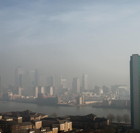Save your breath

Indoor air quality (IAQ) is the single biggest health issue for those living in cities. But which aspects of it should consulting engineers and contractors focus on? John Grenville offers two suggestions.
A newly published report, ‘State of Global Air 2018’ (from the Health Effects Institute, and the Institute for Health Metrics and Evaluation’s Global Burden of Disease Project) draws from the most recent evidence and offers a global update on outdoor, or ambient, air pollution.
One of its startling conclusions is that fine particle air pollution is the largest environmental risk factor worldwide, responsible for a substantially larger number of deaths than other more wellknown behavioural risk factors such as alcohol use, physical inactivity, or high sodium intake.
Another of the report’s findings is even more alarming – 95% of the world’s population lives in areas exceeding World Health Organisation (WHO) guidelines for healthy air. Indeed, nearly 60% live in areas that do not meet even the least-stringent air quality target from WHO.
|
IAQ in a nutshell Indoor air quality (IAQ) refers to the nature of air circulating within the spaces in which we work and live. IAQ is not only about comfort (which is affected by temperature, humidity and odours), but also harmful biological contaminants and chemicals present in the space. Indoor air can be up to 10 times more polluted than outdoor air. As well as polluted outdoor air getting into a building, poor IAQ can result from the presence of contamination sources that release gases or particles into the air. These can include organics from building materials, carpet, and other furnishings; cleaning materials; air fresheners; paint; adhesives; photocopying machines, and biological contaminants from dirty ventilation systems. Typical symptoms of poor IAQ include irritation of the eyes, nose, and throat; rashes; fatigue, headaches, and sleepiness; coughs and wheezing, and nausea. Exposure to poor air quality may not result in a rapid, acute onset of symptoms; instead, the effects might be insidious, although some individuals may be particularly sensitive, for example those with asthma. |
|
Air intake screens like this one from Ecex extend the life of internal filters and reduce maintenance |
The focus of the State of Global Air 2018 report is on ambient particulate matter (particulate matter less than or equal to 2.5 micrometres in diameter, also known as PM2.5). However, many of its warnings apply equally to larger airborne particles including pollen, dust, leaves, insects and other detritus. The report also concentrates on the quality of outside air, but this is intrinsically linked with indoor air quality (IAQ); if pollutants enter the building they can get trapped there and build up in concentrations.
Outdoor air pollutants must meet two criteria to be relevant to IAQ and health – they must penetrate inside the building and they must be capable of harming the health of at least some of the building’s occupants.
Leading HVAC contractors’ association, the Building Engineering Services Association (BESA), is sufficiently concerned by the situation to have called for the proposed new Clean Air Act to include measures supporting the role of buildings as ‘safe havens’ from pollution. It believes that a series of low-cost maintenance measures to ensure ventilation systems work properly and incoming air is filtered and cleaned would make a major difference to the health and wellbeing of building occupants.
Considerable investment has already been made into improving the airtightness of buildings to reduce energy consumption and that same process can be used to manage air quality. BESA reckons that a well-sealed building envelope combined with effective filtration of incoming supply air can reduce particle penetration by 78%.
Improving building ventilation is, indeed, a quick, inexpensive and relatively painless process that can help protect people in their offices and homes. However, for it to be effective, it must perform effectively.
The most obvious way to ensure this is to carry out regular maintenance, but there is also another important step that enlightened building services designers and owners take – to employ some form of prefiltration screen fitted outside to the inlet of HVAC plant and equipment which acts as a sieve to capture airborne particulates.
Pre-filtration offers a powerful double whammy: First, it helps to prevent larger particulate matter (PM) from entering the building and affecting people’s health.
Secondly, it stops this PM from interfering with HVAC plant and equipment, including air handling units and condensers. This mitigates clogging and ensures that the equipment continues to work at its optimum in terms of operational performance and energy efficiency.
Clogging of HVAC equipment by airborne debris also restricts the movement of air and means plant has to work harder to draw in its required airflow, costing more money to run and increasing the risk of breakdown and downtime.
One example of pre-filtration is the ECEX Air Intake Screen – essentially a weather-resistant filter designed specifically for high velocity airflow applications such as air handling units, chillers, dry air coolers, condensers, cooling towers and air conditioning units.
These have been proven to extend the life of internal filters; reduce maintenance; eliminate or significantly reduce coil cleaning; lower energy consumption, and reduce the requirement for cooling tower chemical water treatment.
John Grenville is managing director of ECEX








